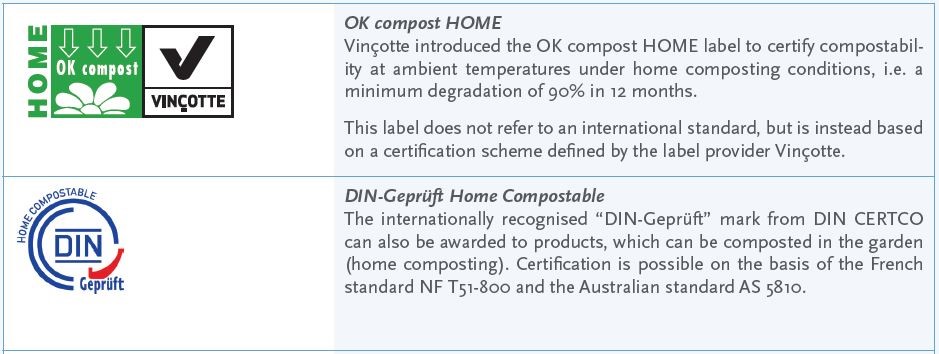- All bio-based plastics are biodegradable – It’s a myth.
Bio-based plastics can be either biodegradable or non-biodegradable (durable).Bio-PET, also known as bio-sourced PET, is a non-biodegradable bio-based plastic that has been around for some years. Bio-PET can replace fossil-based PET in a range of applications. An example is the “Plant Bottle”, a fully recyclable plastic bottle that is made partially from plants. Some bio-based materials, including Bio-PET, are chemically identical to fossil-based ones, so they carry the same properties. They are also called drop-in solutions.
PLA, short for poly lactic acid, is a biodegradable bio-based plastic. It is used for a range of applications, including mulch films, tea bags, drinking cups, and in 3D printing. PLA is transparent and approved for food contact applications and therefore very suitable for food packaging.
PHA, short for poly hydroxyl alkanoates, are polyesters, a kind of polymers, produced in nature by numerous microorganisms, including through bacterial fermentation of sugar or lipids. They are also biodegradable and offer the potential to create bio-based plastics with novel properties.
- If a product is biodegradable, I can throw it into the environment and it will disappear – It’s a myth.
Even though a product might be claimed as biodegradable or compostable doesn’t mean you can just throw it into the environment. The right treatment of a product at its end of life is very important. Biodegradability does not automatically mean that a product will degrade in any environment. In most cases industrial composting with specific conditions is needed to ensure biodegradation within a reasonable period. European standards require that in industrial composting facilities materials need to biodegrade within six months, but in open environments, it will take much longer. And if you wait for hundreds of years, even “durable” goods will start to degrade. Besides, biodegradable plastics are no solution to littering, and can be a sore to the eye. Apply reusable products and materials whenever possible. - If a product is biodegradable, I can easily compost it at home – It’s a myth.
Compostable means that material is certified according to the European standards EN 13432 (packaging) and EN 14995 (products) and is composted in industrial plants. In most cases biodegradable plastics will only degrade in industrial composting plants under specific conditions, because compostability or biodegradability does not automatically mean that a product will degrade in any environment. Degradation is dependent on factors such as temperature, time, humidity and the presence of bacteria and fungi in the specific environment. These factors can be controlled only in industrial composting plants.Nevertheless some products might be suitable for home composting. Even though a European standard for home composting does not yet exist, there are a few standards on national level already in place. Two examples for home composting labels are:

Composting of bio-based plastics only makes sense for specific applications where recycling is too difficult, for instance, because the packaging is highly contaminated with organic residues. An example where composting makes sense is the use of tea bags. To seal tea bags, most tea bags consist of 20-30% of the fossil plastic PP (polypropylene). These tea bags often end up in the composting bin, although they are not compostable. By replacing the PP with PLA the tea bag becomes fully industrially compostable. - Industrial composting plants happily accept compostable plastics – It’s a myth
There is currently a debate under waste management companies and manufacturers as to whether compostable bio-based plastic is suitable for composting in industrial plants. Some composters argue that in practice, the residence time of green waste in today’s composting plants is considerably shorter than the residence time assumed in European composting standards. As a result the process is too short for some bio-based plastic to biodegrade fully. The remains of bio-based plastic and fossil-based plastic look very similar. Both are removed as contaminants and thermally recycled (incinerated) after collection.Other composters, such as the Austrian compost and biogas association, advocate that all single use plastic bags found in supermarkets should be compostable bags to facilitate the collection of bio waste. Manufacturers also argue that compostable waste bags, for example, can be composted within the regular turnaround times, as the materials are much thinner than the values set out in the European composting standard.
- Bio-based plastics, no matter if they are biodegradable or not, could be recycled – It’s a fact.
Theoretically, all bio-based plastics can be recycled. Recycling means reprocessing a used material into a new product. Our daily products are made of different kinds of fossil and bio-based plastics which can be separated through various mechanical processes (sorting) in recycling plants. The separated plastics can be reused for new products after processing (remelting or granulation). Bio-based “drop-in plastics” such as “Bio-PE” or “Bio-PET” are chemically identical to their fossil based versions Polyethylene (PE) and Polyethylene terephthalate (PET). Therefore they can be perfectly integrated in established recycling streams. Other bio-based plastics need to be recycled in separate streams for each material type, because the purity of recyclate streams is important. But right now volumes of other bio-based plastics are not large enough to have the recycling done economically even though it would be technically possible. This might change when volumes increase. Until then bio-based plastics which are not drop-ins will normally go to waste incineration plants which allows at least the recovery of energy. In comparison to fossil based plastics, the CO2 from incinerated bio-based plastics was recently captured and will be captured again when new bio-based products will be produced. CO2 from fossil based plastics was captured a long time ago and therefore contributes to an increase of greenhouse gas concentration in the atmosphere.
—
08/11/2018